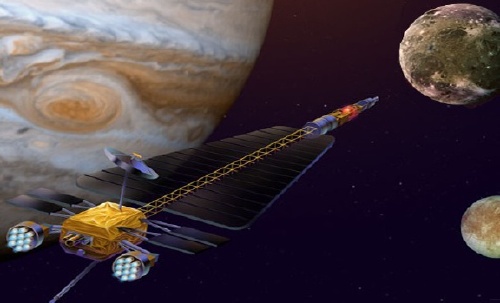 |
|||||
|---|---|---|---|---|---|
| EXPLORING THE JUPITER SYSTEM | |||||
| Jupiter | Moons | Oceans | Volcanos | Rings | Radio |
| JIMO | Galileo | Cassini | Pioneer | Voyager | Resources |
Jupiter's moon Io:
Most Volcanic World In Our Solar System
MOONS OF THE SOLAR SYSTEM »
Jupiter's sulfurous moon Io is the innermost of the giant planet's four largest moons and the most volcanic world in our Solar System. In fact, Io is peppered with hundreds of volcanoes, several of which might be active at any given moment.
NASA engineers sent the Galileo spacecraft on a close encounter with the north pole of Io on August 6, 2001, to take unprecedented magnetic measurements and to examine the site of a recent volcanic eruption.
Galileo sped across an area of Io called Tvashtar at an altitude of only 200 km.
That area had been seen belching a giant plume of volcanic gases only seven months before. Scientists hoped the volcano might still be active so Galileo could fly right through a volcanic plume for the first time.
Volcanic plumes in Io's polar regions don't show up often and then are short-lived. When they assigned the task to Galileo, the scientists didn't know whether the Tvashtar volcano would be erupting or not.
Tides make Io fiery. Of course, those are not like ocean tides on Earth. Rather, they are tidal bulges in the solid crust of the moon Io. Jupiter's gravitational field and the gravitational fields of its other large moons raise the bulges on Io as high as a 30-story building.
The bulges move as Io orbits the giant planet. Io's crust flexes and heats the moon's interior. That is the source of energy for volcanoes that seem to constantly spew lava.
Galileo also conducted two close flybys of Io in 1999 to study and photograph that moon's intense volcanic activity.
In 2001, Galileo went dashing through the snows of Io. As the spacecraft flew past the north pole of the moon, it sailed through a swarm of sulfurous snowflakes hurled into space by a previously uncharted volcano. Scientists who had not expected the probe to encounter fresh volcanic ash were delighted.
Galileo also photographed a slumping cliff, migrating eruptions and churning lava lakes on Jupiter's sizzling moon.
Solar System Search STO STO cover Questions Feedback Suggestions © 2004 Space Today Online